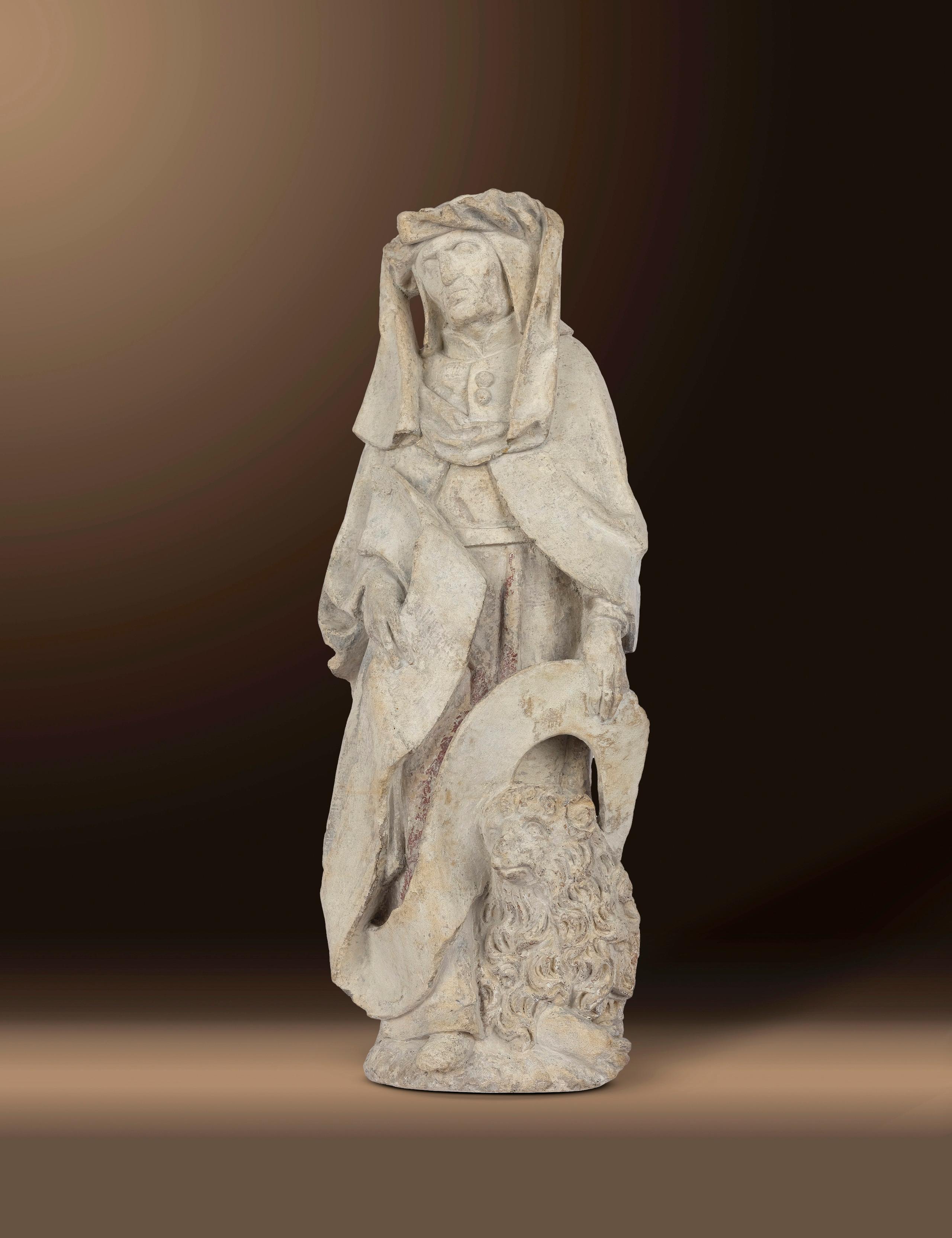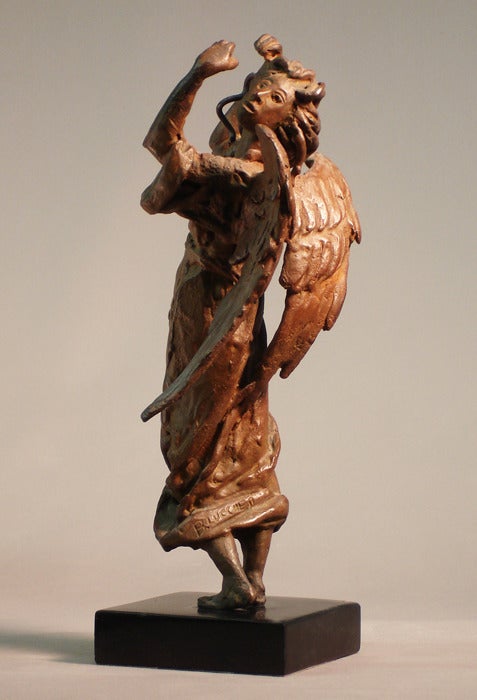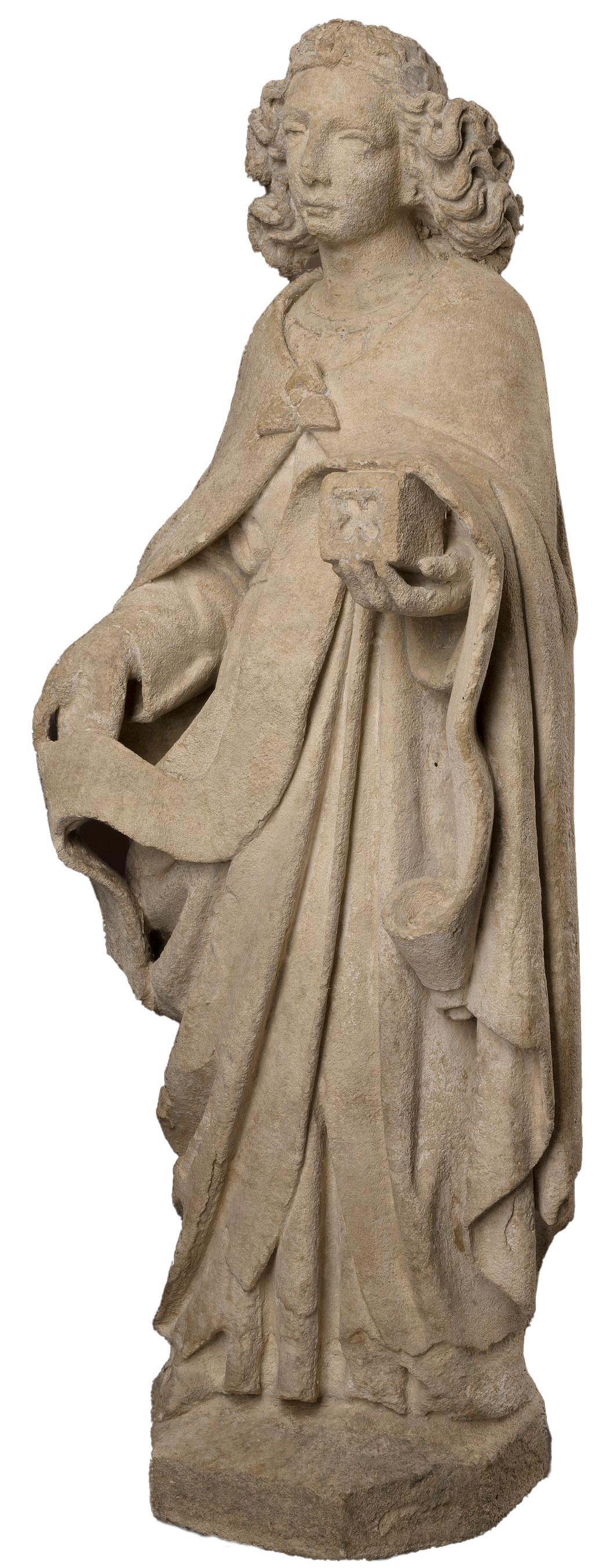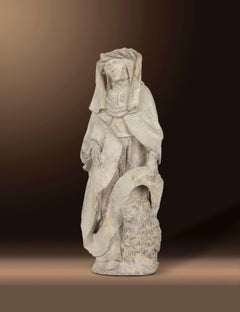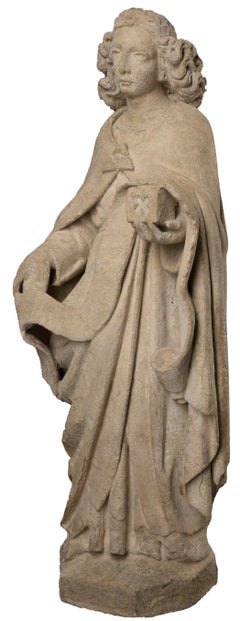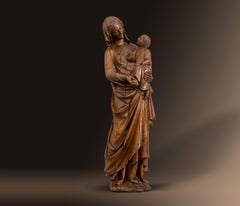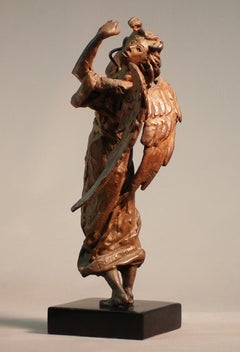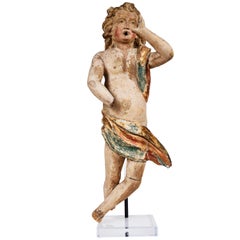Want more images or videos?
Request additional images or videos from the seller
1 of 9
UnknownMaster Angel1500/20
1500/20
$38,000
£28,696.08
€32,854.37
CA$53,665.93
A$58,590.35
CHF 30,716.52
MX$711,602.40
NOK 383,599.39
SEK 362,220.11
DKK 245,222.89
About the Item
MASTER ANGEL
Museum sculpture of the master of Mauer
Austrian Danube Region
Around 1500/20
Lime wood, carved full round
Height 55 cm
Provenance:
Hofstätter Collection, Vienna
The masterful sculpture was made in the workshop of the master of the altar of Mauer around 1500 in Lower Austria. It can be located in the context of the Danube school of the first third of the 16th century, was carved from limewood and is 55 cm tall. Since there are no attributes or context, it is an unknown figure of a carved altar.
The master of the altar of Mauer is an anonymous Gothic carver who was active between 1500 and 1525 and received this so-called emergency name through the altar for the parish and pilgrimage church of Mauer near Melk. This winged altar was probably commissioned by Göttweig Abbey in the 1470s and is made of lime wood. It shows an expression in the transition from late Gothic to early Renaissance and is considered the most important carved altar in Lower Austria, created between 1510-15.
The figure presented here is very related in its design to the figures of the altar of Mauer. In lively-moving form, the male figure turns his upper body to the right, with his head pointing upward, probably toward the sky. The right leg in lunge emerges from under the frock-like clothing; the bare foot is placed in a stable position on the entire sole of the foot in front of the body. As if paused in motion, his hands are clasped in front of his chest in a gesture of prayer, giving a closed impression despite the figure’s expansive effect. This dynamized physicality is underlined by the richly elaborated and angular drapery of the robe. Particularly similar is the puffed, belted upper garment like that of the Archangel Gabriel in the Annunciation scene of the altar of Mauer. However, the restrained treatment of the clothing suggests that this is a secondary figure, possibly a shepherd. Other typical features of this masterful image carver are an angular face shape and characteristic physiognomy with strongly modeled skin surfaces, deep-set, sharply defined eye areas and accentuated dimples on the chin.
These features come out particularly well due to the absence of polychromy. Just like the altar of Mauer, this figure could have been designed for wooden visibility. Adolf Schmidl describes this in his travelogue from 1835 as the “genius of the master without all cover” (Adolf Schmidl, Wien’s Umgebungen auf zwanzig Stunden im Umkreise. After own wanderings described by Adolf Schmidl, Vienna 1835, p. 331). It is conceivable that the active master did not employ a barrel painter in his workshop who could have painted the figures and reliefs. It is possible that the commissioned works, such as the altar at Mauer, were delivered without polychromy. The altar also remained wooden; whether due to lack of money or for aesthetic reasons is unclear. This is also said to be the case, for example, with the carvings of Tilman Riemenschneider, an important sculptor of the late Gothic period, who merely gave the figures a tinting glaze and partial polychromy.
The facial physiognomy with thin brows, a prominent nose and chin, and full lips is further related to the drawing of a bust of a monk by Martin Schongauer (1450/91). This could have been included in a composition that was disseminated as a copperplate engraving and served as a model for carvings, as is also reflected in the reliefs of the altar at Mauer near Melk. While the form and expression still have elements of the late Gothic, the twisted movement of the figure reveals a threshold position to the early Renaissance.
- Creation Year:1500/20
- Dimensions:Height: 21.66 in (55 cm)Width: 8.27 in (21 cm)
- Medium:
- Period:
- Condition:Very good condition.
- Gallery Location:Wien, AT
- Reference Number:1stDibs: LU1143210963472
About the Seller
No Reviews Yet
Vetted Professional Seller
Every seller passes strict standards for authenticity and reliability
Established in 1986
1stDibs seller since 2019
- ShippingRetrieving quote...Shipping from: Wien, Austria
- Return Policy
Authenticity Guarantee
In the unlikely event there’s an issue with an item’s authenticity, contact us within 1 year for a full refund. DetailsMoney-Back Guarantee
If your item is not as described, is damaged in transit, or does not arrive, contact us within 7 days for a full refund. Details24-Hour Cancellation
You have a 24-hour grace period in which to reconsider your purchase, with no questions asked.Vetted Professional Sellers
Our world-class sellers must adhere to strict standards for service and quality, maintaining the integrity of our listings.Price-Match Guarantee
If you find that a seller listed the same item for a lower price elsewhere, we’ll match it.Trusted Global Delivery
Our best-in-class carrier network provides specialized shipping options worldwide, including custom delivery.More From This Seller
View AllHl. Hieronymus
Located in Wien, Wien
St. Jerome
347 Stridon, Croatia - 420 Bethlehem
Around 1500/20
Limestone
Remains of the original polychromy
Height 45 cm
The man with the holy name!
347 Stridon, Croation – 420 Be...
Category
16th Century Figurative Sculptures
Materials
Limestone
Standing Engel
Located in Wien, Wien
Standing angel with banner
Flemish
Around 1450/60
Sandstone
60 x 21 x 15 cm
This museum figurine shows a standing angel with a banner in his right hand and a small box in his left. The youthful, ageless figure wears a coat held together with a triangular, floral brooch in front of the chest over a long robe. The angel’s gaze is directed forward, his head tilted slightly to the left. The elongated face is sculpted: the large almond-shaped eyes with accentuated upper and lower eyelids are alertly open and sharp eyebrows lead directly into the root of the nose. The straight nose above the pronounced mouth completes the idealized oval face of the angel and his calm, internalized facial expression. What is particularly remarkable, however, is the magnificent curls, which are only partially tamed by a simple headband. As if puffed up by the wind, the hair, which is sometimes streaked in parallel, sometimes wildly twisted and richly curled, stands out dynamically from the ears. The tilted head with these sideways protruding waves of hair thus conveys an immediate impression of movement. The physicality of the sculpture is expressed particularly through this organic, lifelike movement of the loosened hair.
The lively overall impression of the figure is further enhanced by the multiple rolled banners that the angel presents to the viewer. The outstretched palm of the right hand appears both intimate and confidential as well as mystically revealing. This banderole winds in gentle curves in front of the figure’s body, throws a fold over the second attribute in the angel’s left hand and falls downwards in a loose manner. The volute-shaped rolled up end of the banner clearly shows the fine texture of the banner and at the same time draws the viewer’s attention to the small cube-shaped box that the angel is holding in its slender, long-limbed fingers. The cube is decorated with a Gothic quatrefoil motif, which is often seen in the architectural tracery of windows, but was also often used to decorate caskets and other small treasures. The sweeping gestures in the presentation of the attributes suggest three-dimensionality, in contrast to the tubular folds at the base of the neck and the intricate draperies in flat and multiple overlapping garment sections. The soft curves of the folds give the impression that the clothing is made of a heavy fabric that falls diagonally down the front and is laid in several bowl folds under the right hand.
Overall, the sculptural work testifies to the highest artistic skill, which emphasizes the virtuosity of sculpture in its precious and representative overall impression. The memorable characteristics recognizable here can be seen in comparable pictorial works from Utrecht around the middle of the 15th century, when sculptural art – especially stone sculpture – was characterized by a remarkably high quality. Particularly noteworthy is the accentuated Utrecht head type with an elongated oval face, almond-shaped eyes with heavy lids and dense, vividly protruding tufts of hair framing the head. For example, the figure is comparable to a capital of an angel on the east side of the rood screen of the Joriskerk in Amersfoort (province of Utrecht) from the second quarter of the 15th century. Not only the physiognomy and hair, which in the comparative example stand somewhat more horizontally to one side, but also the garment puff above the girdle are similar. Even more related motifs, such as the cleverly placed bowl folds, can be found on the limestone figure...
Category
15th Century and Earlier Figurative Sculptures
Materials
Sandstone
Apostel group
Located in Wien, Wien
APOSTLE GROUP
ORIGINAL VERSION
Flemish/Brabant
Around 1500
Oak wood carved
Height 37.5 cm, width 12 cm,
Depth 12.5 cm
Category
15th Century and Earlier Figurative Sculptures
Materials
Wood
$19,800
Madonna
Located in Wien, Wien
MADONNA
Il DE FRANCE/PARIS
Around 1270
Oak wood carved
Height 79cm
Category
15th Century and Earlier Figurative Sculptures
Materials
Oak
Price Upon Request
Sedes Sapientiae
Located in Wien, Wien
Sedes Sapientiae
Pustertal um 1220/30
Weichholz/Lindenholz(?)geschnitzt
Reste von originaler Polychromie
Höhe 57 cm
Category
15th Century and Earlier Figurative Sculptures
Materials
Wood
Madonna
Located in Wien, Wien
MUSEUM SCULPTURE
Master workshop
Hans Klocker
before 1474, possibly in Gais -
After 1500
"CRESCENT MOON"
Around 1480/90
Stone pine wood carved
Original version
Height 77 cm
This ext...
Category
15th Century and Earlier Figurative Sculptures
Materials
Wood
Price Upon Request
You May Also Like
Angel
By Bruno Lucchesi
Located in Greenwich, CT
Unique bronze sculpture of an angel
Category
20th Century Figurative Sculptures
Materials
Bronze
Peace
Located in PARIS, FR
Peace
by Jules COUTAN (1848-1939)
Bronze sculpture with a dark brown patina
Signed on the base " Jules Coutan "
Cast by " Thiébaut Frères Fondeurs Paris " (with the foundry stamp)
P...
Category
Late 19th Century French School Figurative Sculptures
Materials
Bronze
$12,274
Important Sculpture
Located in ROUEN, FR
"Important Sculpture
IMPORTANT SCULPTURE representing Saint Floran de Lorch in polychrome wood in its beautiful old polychromy. He is represented ...
Category
16th Century Figurative Sculptures
Materials
Wood
$8,122
18th Century, Heralding Angel Sculpture
Located in Los Angeles, CA
An iconic, hand carved, gessoed, painted, and parcel-gilt, Italian polychrome sculpture of tousle curled angel in windswept drapery. Beautiful expression and patina. Now mounted on a...
Category
1730s Figurative Sculptures
Materials
Paint, Wood
"Sapphos"
Located in Astoria, NY
After Edouard Henri Delesalle (French, 1823-1851) "Sapphos" Patinated Bronze Sculpture, late 19th century, impressed to base "F. Barbedienne, fondeur" and "Reduction Mecanique A. Col...
Category
Late 19th Century French School Figurative Sculptures
Materials
Bronze
Baroque Italian master - 17/18th century figure sculpture - Saint
Located in Varmo, IT
Carved and painted wooden sculpture - Figure of a saint - Italy, 17th-18th century.
36 x 25 x 74 cm.
Made entirely of carved, lacquered, and painted wood. Some signs of wear and pa...
Category
Late 17th Century Baroque Figurative Sculptures
Materials
Wood, Paint
$3,008 Sale Price
28% Off
More Ways To Browse
Antique Angels
Wood Angel Sculpture
Archangel Gabriel
16th Century Angel
16th Century Wood Angel
Burning Man Sculpture
Camille Claudel Sculptures
Doug Robinson
Erte Rigoletto
Isabelle Thiltges
Jean Louis Corby
Jeon Kang Ok
Joan Cornella
Kaws 2006
Kaws Black Dissected
Kaws What Party Black
Kaws What Party White
Last Rites
